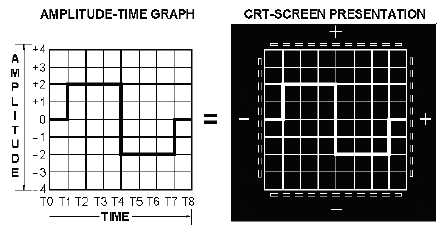6-8
Figure 6-10.—Amplitude versus time.
1. From T0 to T1, the vertical plates maintain their static difference in potential and the beam stays
at 0 units; the T0 to T1 change causes an increasing potential difference in the horizontal plates,
and the beam moves 1 unit to the right.
2. At T1, a positive potential difference change in the vertical plates occurs, which causes the beam
to move up (instantaneously) 2 units. This vertical (amplitude) beam location is maintained from
T1 to T4; horizontal beam movement continues moving to the right as 3 units of time pass.
3. At T4, an instantaneous negative change in potential of 4 units in amplitude occurs, and the beam
moves from +2 to -2 units.
4. From T4 to T7, the beam remains at -2 units. During this time period, the beam continues
moving horizontally to the right, indicating the passage of time.
5. At T7, a positive increase of amplitude occurs, and the beam moves vertically from -2 to 0 units.
From T7 to T8, no change occurs in vertical beam movement; however, horizontal movement
continues with time.
The vertical-plate potential difference follows the voltage of the waveform. The horizontal-plate
potential follows the passage of time. Together, they produce the image (trace) produced on the screen by
the moving beam.
Q-10. The vertical-deflection plates are used to reproduce what function?
Q-11. The horizontal-deflection plates are used to produce what function?
HORIZONTAL-DEFLECTION PLATES.—Now let's look at horizontal-deflection action.
Assume that the resistance of the potentiometer shown in figure 6-11 is spread evenly along its length.
When the arm of the potentiometer is at the middle position, the same potential exists on each plate. Since
there is zero potential difference between the plates, an electrostatic field is not moved downward at a
uniform rate; the right plate will become more positive than the left (you are looking down through the
top of the CRT). The electron beam will move to the right from screen point 0 through points 1, 2, 3, and
4 in equal time intervals.


